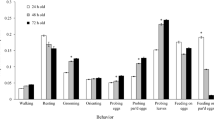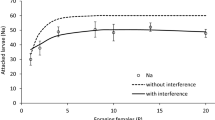Abstract
Selected nutritional and developmental factors regulating the predatory behavior of first-instar spined assassin bugsSinea diadema (Fabricius) (Hemiptera: Reduviidae) were investigated. The longevity of unfed nymphs provided with free water, bean pod sections, or glucose solutions was not significantly greater than that of unfed nymphs which were not provided with a source of water. First-instarS. diadema that were provided with larvae ofEphestia kuehniella Zeller (Lepidoptera: Pyralidae) as prey began feeding 1.9 (±0.9) days after hatching. In contrast, first-instarS. diadema that were provided with conspecifics of the same age did not begin feeding until they were 3.9 (±0.9) days old. These results suggest that the potential nutritional benefits to be gained from feeding equal or outweigh the risk of attacking prey capable of effective self-defense only when nymphs have not fed for 4 days after hatching. Providing the nymphs with water or glucose solutions significantly delayed the onset of conspecific predation. Additional data are presented which demonstrate that first-instarS. diadema are not restrained from preying on siblings by kin recognition.
Similar content being viewed by others
References
Baur, B. (1987). Can cannibalistic hatchlings of the land snailArianta arbustorumn distinguish between sib and non-sib eggs?Behaviour 103: 259–265.
Carcamo, H., and Spence, J. R. (1993). Kin discrimination and cannibalism in waterstriders (Gerridae). Entomological Society of America 1993 Conference Program, p. 35.
Cobben, R. H. (1979). On the original feeding habits of the Hemiptera (Insecta): A reply to Merril Sweet.Ann. Entomol. Soc. Am. 72(6): 711–715.
Cohen, A. C. (1990). Feeding adaptations of some predaceous hemiptera.Ann. Entomol. Soc. Am. 83(6): 1215–1223.
Croy, M. I., and Hughes, R. N. (1991). Effects of food supply, hunger, danger and competition on choice of foraging location by the fifteen-spined stickleback,Spinachia spinachia L.Anim. Behav. 42: 131–139.
DeBach, P., and Rosen, D. (1991).Biological Control of Natural Enemies, Cambridge University Press, Cambridge.
Dethier, V. G. (1976).The Hungry Fly, Harvard University Press, Cambridge, MA.
Edwards, J. S. (1962a). A note on water uptake and gustatory discrimination in a predatory reduviid (Hemiptera).J. Insect Physiol. 8: 113–115.
Edwards, J. S. (1962b). Observations on the development and predatory habit of two reduviid Heteroptera,Rhinocoris carmelita Stal andPlatymeris rhadamanthus Gerst.Proc. Roy. Entomol. Soc. Lond. (A) 37: 89–98.
Edwards, J. S. (1966). Observations on the life history and predatory behavior ofZelus exsanguis (Stal) (Heteroptera: Reduviidae).Proc. Roy. Entomol. Soc. Lond. (A) 41: 21–24.
Evans, E. W. (1982). Feeding specialization in predatory insects: Hunting and attack behavior of two stinkbug species (Hemiptera: Pentatomidae).Am. Mid. Nat. 108(1): 96–104.
Kiman, Z. B., and Yeargan, K. V. (1985). Development and reproduction of the predatorOrius insidiosus (Hemiptera: Anthocoridae) reared on diets of selected plant material and arthropod prey.Ann. Entomol. Soc. Am. 78(4): 464–467.
Krebs, J. R. (1978). Optimal foraging: decision rules for predators. In Krebs, J. R., and Davies, N. B. (eds.),Behavioral Ecology: An Evolutionary Approach, Blackwell, Oxford, Melbourne, pp. 23–63.
Marston, N. L., Schmidt, G. T., Biever, D. D., and Dickerson, W. A. (1978). Reaction of five species of soybean caterpillars to attack by the predator,Podisus maculiventris.Environ. Entomol. 7(1): 53–56.
Molles, M. C., Jr., and Pietruszka, R. D. (1987). Prey selection by a stonefly: The influence of hunger and prey size.Oecologia 72: 473–478.
Molles, M. C., Jr., and Pietruszka, R. D. (1983). Mechanisms of prey selection by predaceous stoneflies: Roles of prey morphology, behavior and predator hunger.Oecologia 57: 25–31.
Naranjo, S. E. and Stimac, J. L. (1985). Development, survival, and reproduction ofGeocoris punctipes (Hemiptera: Lygaeidae): Effects of plant feeding on soybean and associated weeds.Environ. Entomol. 14: 523–530.
Nummelin, M. (1989). Cannibalism in waterstriders (Heteroptera: Gerridae): Is there kin recognition?Oikos 56: 87–90.
Parker, A. H. (1965). The predatory behavior and life history ofPisilus tipuliformis Fabricius (Hemiptera: Reduviidae)Entomol. Exp. Appl. 8: 1–12.
Pastorok, R. A. (1980). The effects of predator hunger and food abundance on prey selection byChaoborus larvae.Limnol. Oceanogr. 25(5): 910–921.
Pyke, G. H., Pulliam, H. R., and Charnov, E. L. (1977). Optimal foraging: a selective review of theory and tests.Q. Rev. Biol. 52(2): 137–154.
Radwan, J. (1993). Kin recognition in the acarid mite,Caloglyphus berlesei: Negative evidence.Anim. Behav. 45: 200–202.
Readio, P. A. (1924). Notes on the life history of a beneficial reduviid,Sinea diadema (Fabr.), Heteroptera.J. Econ. Entomol. 17: 80–86.
Ruberson, J. R., Tauber, M. J., and Tauber, C. A. (1986). Plant feeding byPodisus maculiventris (Heteroptera: Pentatomidae): Effect on survival, development, and preoviposition period.Eviron. Entomol. 15: 894–897.
Salas-Aguilar, J., and Ehler, L. E. (1977). Feeding habits ofOrius tristicolor.Ann. Entomol. Soc. Am. 70(1): 60–62.
Smith, J. J. B. (1985). Feeding mechanisms. In Kerkut, G. A., and Gilbert, L. I. (eds.),Comprehensive Insect Physiology, Biochemistry, and Pharmacology, Vol. 4, Pergamon, Oxford, England.
Sokal, R. R., and Rohlf, F. J., (1981).Biometry, 2nd ed., W. H. Freeman, San Francisco, CA.
Stoner, A. (1970). Plant feeding by a predaceous insect,Geocoris punctipes.J. Econ. Entomol. 63: 1911–1915.
Stoner, A., Metcalfe, A. M., and Weeks, R. E. (1975). Plant feeding by Reduviidae, a predaceous family (Hemiptera).J. Kans. Entomol. Soc. 48(2): 185–187.
Sweet, M. H. (1979). On the original feeding habits of the Hemiptera (Insecta).Ann. Entomol. Soc. Am. 72(5): 575–579.
Tallamy, C. D., and Tallamy, D. W. (1993). The effect of relatedness onGargaphia egg dumping behavior.Anim. Behav. 45: 1239–1241.
Taylor, J. R., and Schmidt, J. M. (1994). Aggression and risk assessment during predatory interactions between first instarSinea diadema (Fabricius) (Hemiptera: Reduviidae).J. Insect Behav. 7(3): 297–311.
Wigglesworth, V. B. (1965).The Principles of Insect Physiology, 6th ed., Methuen, London.
Wilson, E. O. (1987). Kin recognition: An introductory synopsis. In Fletcher, D. J. C., and Michner, C. D. (eds.),Kin Recognition in Animals, John Wiley and Sons, New York, pp. 7–18.
Author information
Authors and Affiliations
Rights and permissions
About this article
Cite this article
Taylor, J.R., Schmidt, J.M. Factors regulating predation by first-instar spined assassin bugs [Sinea diadema (Fabricius)] (Hemiptera: Reduviidae). J Insect Behav 9, 23–35 (1996). https://doi.org/10.1007/BF02213721
Revised:
Issue Date:
DOI: https://doi.org/10.1007/BF02213721




